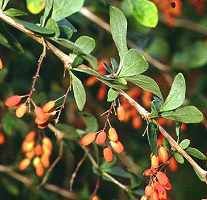

Barberry (Berberis aquifolium, B vulgaris)
Folk Names: Algerita, American Barberry, Blue Barberry, California Barberry, Creeping Barberry, Holly Grape, Mahonia, Mountain Grape, Mountain Holly, Oregon Grape, Oregon Grape Root, O Ti Toque, Rocky Mountain Grape, Trailing Grape; Bv Berberry, Berberis Dumetorum, European Barberry, Holy Thorn (Italy), Jaundice Berry, Pepperidge, Pepperidge Bush, Pipperidge Bush, Piprage, Sourberry, Sowberry, Wood-sour
Description: There are 175 species of deciduous shrub making up the Berberidaceae family. Many of these are used as ornamental plantings and for hedges. The Barberry is native to temperate zones and grows wild in the New England states and in the mountains of Pennsylvania and Virginia. Other better varieties include Nepal Barberry or Darlahad (B aristata) and Indian Barberry (B asiatica).
Berberis aquifolium prefers hard gravelly soil and may be found in the Northeastern states and sometimes in the rich soils of the western states. The root is yellow on the outside. The bark of the barberry is bitter, reddish when young and dirty gray as the bush matures. It will grow from three to eight feet. The leaves are obovate to oval with soft, bristly points. The primary leaves on the woody shoots are reduced to three-forked spines with an enlarged base, and the secondary leaves grow from the axils of these spines. The small, yellow flowers appear from April to June and hang from the branches in clusters. Bright red, oblong berries ripen from August to September with an agreeable acid taste. These should only be eaten when ripe. The fruit of some species grow so dark as to be dark blue or almost black.
Berberis vulgaris grows in thickets, pastures, and wet places. It is a European species but may also be found from Nova Scotia south to Delaware and Pennsylvania and west to Missouri, Minnesota, and Iowa. This deciduous shrub will grow up to ten feet. The leaves are oval to oblong and spiny toothed, pale green above, and grayish green below. The small, yellow flowers appear from May to June in drooping clusters. The clusters later produce oval, orange-red to scarlet-red fruits.
Effects: gentle
Planet: Mars
Element: Earth
Associated Deities:
Traditions:
The name, Holy Thorn, comes from a belief that it was one of the woods used in the Crown of Thorns.
Magic:
The root is carried to attract money, financial security, and popularity.
P> Known Combinations:
In Egypt, syrup of barberry and fennel seed was used against plagues.
Medical Indications: (Caution: should not be used during pregnancy)
(Note: can be used in place of goldenseal for some purposes)
Parts Used: root (gathered in Spring and Fall), ripe berry, bark
Barberry decreases the heart rate, slows breathing, purifies the blood and cleanses liver, reduces bronchial constriction and stimulates movement. Topically, it will kill bacteria on the skin and is good for many skin conditions, acne to psoriasis.
Without ready access to modern medicine, the root of B Aquifolium may be chewed and spit on injuries and wounds to reduce the risk of infection. Tea from the root is a blood tonic, cough medicine, and stimulates the kidneys. A decoction may be made for heartburn, rheumatism, and consumption. The bark and roots are effective for stomach problems and hemorrhages.
The root of B vulgaris is hepatic, laxative, antibacterial, and antiseptic, while the berries have a laxative and refrigerant effect. The root bark contains alkaloid that promotes bile secretion and helps liver ailments. It dilates blood vessels and lowers blood pressure. A teaspoon of root or infusion of berries in wine purges the bowels, and a decoction of berries or root may be used as a mouthwash, a gargle for mouth and throat irritations, and eye drops for blood shot eyes. The fresh juice of berries strengthens the gums and relieves pyorrhea when brushed onto or directly applied to the gums.
Nutrition:
Barberry is found mainly in the wild. Efforts have been made to eradicate the shrub due to the fact that it plays host to one phase of wheat rust. The berries are comparable to cranberry in taste, and they may be used similarly in cooking. The fruit of barberry is used for jelly, cooked fruit, and cold drinks. They are rich in pectin and so are easily transformed into jellies. The fruit may also be dried like raisins. Hikers may chew the young leaves, and they may be added to salads or to season meat.
Mercantile Uses:
The flowers of barberry are a favorite among insects. While they will attract bees, they will also attract other insects as well.
The yellow wood is sometimes used for jewelry (especially by Spanish Americans who used it for crucifixes The leaves make a black dye combined with copperas, and the roots are boiled in lye for yellow dye. This yellow dye was important for baskets, buckskins, and fabrics among the Native Americans, and is used in Poland as well. With alum, the inner bark of the twigs is suitable for use with linen. The twigs and young leaves make a red-yellow color.